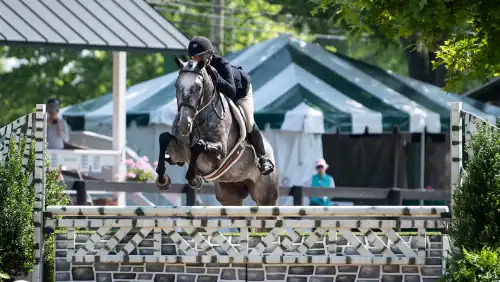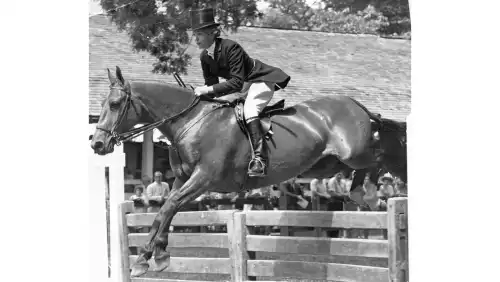The $150,000 WCHR Peter Wetherill Palm Beach Hunter Spectacular is one of the biggest classes of the year for show hunters, held under the lights in front of packed stands, with even more people watching online. Maria Rasmussen has done the class a handful of times before, and she entered the ring Saturday night on a promising 8-year-old called SVF Changeup hoping for a top-12 finish.
But almost as soon as they entered the lights and atmosphere of the International Ring at Wellington International for “Casey’s” first night class, his head went straight up “like a periscope,” eyes open wide, and Rasmussen knew that goal was likely out the window.
“We picked up a trot, and he was like, ‘Ooo!’ and I was like, ‘Uh oh,’ ” Rasmussen recalled.
Instead of vying for a top placing, Rasmussen switched gears to rely on her years of experience with young horses and “do what feels good” moment to moment for the Dutch Warmblood (Il Est Balou—Fabiola, Arthos R), owned by Kristen Hamel’s Sunset View Farm LLC, who qualified for the class by earning the reserve championship in the high performance conformation hunter division.
The result was a performance that earned the lowest score of the night but produced a lesson in horsemanship of those watching live and online.

‘Do What Feels Good’
As Rasmussen tried to help Casey relax in the electric environment, and she evaluated the best course of action, an old piece of advice from two friends came into her head.
“One time when I was having a bad time, I just said, ‘I don’t know what to do,’ they both said, ‘Do what feels good. Don’t do what feels bad,’ ” said Rasmussen. “It was just as simple statement, but it’s always stuck with me.”
Rasmussen walked and toured the ring for as long as she dared, then picked up the canter, while Casey’s “legs felt they were going everywhere.”
“I don’t know what to do,” she said of riding the obviously nervous gelding. “But I guess, do what feels good, don’t do what feels bad. So what felt right was for him to stay out there and see what happened, and if I only got a couple jumps in, at least he had the experience.”
ADVERTISEMENT
And Rasmussen did that.
“He’s done that before but never held onto it,” she said of Casey’s initial bug-eyed reaction to the atmosphere. “He’ll walk in the ring, and he’ll kind of—I’ll tease and say he’s like a periscope when he looks at something. Usually we kind of pat him, and we carry on. But obviously it wasn’t that easy this time.”
She guided the tense horse around the beginning of the course with plenty of pats and reassuring words, and when he spooked and jumped to the side of Fence 2, pulling a rail, she brought him to a walk, circled, then gave him a few comforting comments and a rub before recomposing him and aiming him at Fence 3, the out of the line. With every jump she thought, “I’ll just do one more and see how he feels,” and gradually he started to relax.
“By the time I jumped in the second [nine-stride line], I actually let go of the reins for a minute,” she said. “He jumped in, and he stretched a little as I cantered down to the oxer. I was like ‘Oh my god, he’s taking a breath.’ We jumped the second-to-last oxer, and I looked to the last one, and I was like, ‘I don’t see a distance. This would be terrible if I cantered up to that jump and completely missed for you, my poor friend.’
“I always say, if don’t see a distance, remember that you’re in a partnership with that horse,” she continued. “Just take a breath and allow them to help you out. And that’s what I did. I turned the corner and turned to the jump and was like, ‘I really don’t see a distance, buddy.’ At that point he was like, ‘I got you, mom.’ We were a little long, and he was great.”
While the scoreboard flashed her average mark of 30.66—the lowest score of the class—Rasmussen was thrilled for the learning opportunity for her and Casey. In the schooling area his owner, Hamel, came running up to hug Rasmussen and express how elated she was at his improvement over the round.

“I was so happy,” said Rasmussen, 46. “My goal was to make to the top 12. We weren’t going to win the class; I’ve done the class probably five times, but I’m not all that seasoned when it came to that class, and he’s not seasoned. I said, ‘I just want to get into the top 12; that’s all I want to do.’ This was better than that. … At the end of the day, I’m in this for the long haul, for the longevity of it through my career and through the horses. And we both went out there and learned so much. I was just so happy.”
Rasmussen usually leaves posting to her Sea Change Farm Facebook page to her social media manager, but the morning after the big class, she proudly posted a video of her round and wrote about the experience herself.
“Well…… tonight did not go as planned,” she wrote. “I am so proud of my horse and honored that he let me guide him around the night class and finished understanding. Casey (SVF Change Up) was TERRIFIED. He has never done a night class and has had a very short career as a hunter. 2024 being his first full year. Developing young horses is one of the most important parts of our jobs as horsewomen and men and so often it gets lost in the chase for the ribbons. Accomplishing this small triumph with a young horse was so rewarding.
ADVERTISEMENT
“Thank you so much to my team for all of your hard work this week and every week. And thank you to Kristen Hamel for trusting me with your horses. I am so proud of what we do together and excited for what’s to come.”
Rasmussen closed Facebook and went to work, and when she opened the app back up later that day, she was shocked at the reactions to the post. Within a day and a half the post had over 400 shares, and by Monday it had thousands of reactions and comments.
“There wasn’t one negative comment,” said Brian Brown, Rasmussen’s life and business partner at Sea Change Farm. “In this armchair world we live in, that’s so unusual.”
Looking back, Rasmussen said she wouldn’t have changed her preparation for Casey’s first night class. She jumped a few spooky fences at home, rode him in the International Ring, and she hacked him around the show grounds in an effort to make him bored of the competition.

“We tried. It didn’t fully work, but myself and my team, there was nothing we were going to do to make that not happen. It’s just horses,” she said.
Rasmussen, who lives in Royal Palm Beach, Florida, with her 14-year-old son Owen Rasmussen and Brown, loves training young horses and the small wins they can accomplish together.
“Just having the tiniest little triumph in a day or a simple thing like, ‘He just did that simple lead change so perfect,’ or, ‘We showed in the 3- and 4-year-old [division], and he cantered down to the first jump without even taking a peek,’ ” she said. “We might not have done any lead changes and added in the lines, but he didn’t spook at all, and you come out of the ring, and you’re so happy about that.”
She only has one truly young horse right now, a 4-year-old she co-owns with Vanessa Wendt that she got when he was 10 days under tack. She’s been developing young horses since she worked with Steve Wall for 10 years early in her professional career.
“We always had a lot of young horses,” she said. “I had a young horse, I got her as a 2-year-old, and I ended up breaking her and selling her, and that’s how I paid for my wedding.”
While Casey has been in the show ring since he was 5, Maria’s experience holding the hand of young horses helped her have a successful outing that night.
“We have partnerships with horses and friendships,” she said. “They’re our team, they’re our family, all the things, and it’s just about developing them and teaching them and also honoring them because they give us so much they do not have to. If you are good to them and bring them along the right way, I do think they love what they do.”














